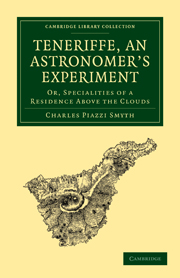Summary
September 26th saw us riding from Orotava to Santa Cruz.
During the first part of the journey, while still in that depressed or fallen-in region of the valley of Taoro; gardens were thick and close. Of their contents, none were perhaps so admirable as the double oleander; think of a rose-bush at least twenty feet high, and in a perfect explosion of flowers. Peaches were fine, as trees, but the fruit, strangely small; though numerous as the leaves. Date-palms, Phœnix Dactylifera, were not unfrequent; and after ascending the hill surface beyond the valley, villages were passed with almost groves of them. Yet none could be called well-grown. Stunted and stumpy they rather were, more like tree-ferns than palms; and whenever fruit appeared, it seemed dropping off immaturely. Whether the soil or climate be at fault, others must say. The latitude could not be, for in Egypt and Syria, several degrees north of Canary, date-palms wave on stems as tall and graceful as any in the world.
These countries, however, have no Trade-winds blowing on them every day, as in Teneriffe; not only bringing cold air from the Poles, but producing such mists through the greater part of summer, that the chief portion of solar heat, due to latitude, is reflected back to the blue sky, from a brilliant upper surface of an almost permanent sea of clouds.
Under such discouragement, vegetation along the northern coast of the island, is simply not so fine as it might be; with certain exceptions, there is more of the desert, than of the “scenery of plants.”
- Type
- Chapter
- Information
- Teneriffe, an Astronomer's ExperimentOr, Specialities of a Residence Above the Clouds, pp. 428 - 440Publisher: Cambridge University PressPrint publication year: 2010First published in: 1858

